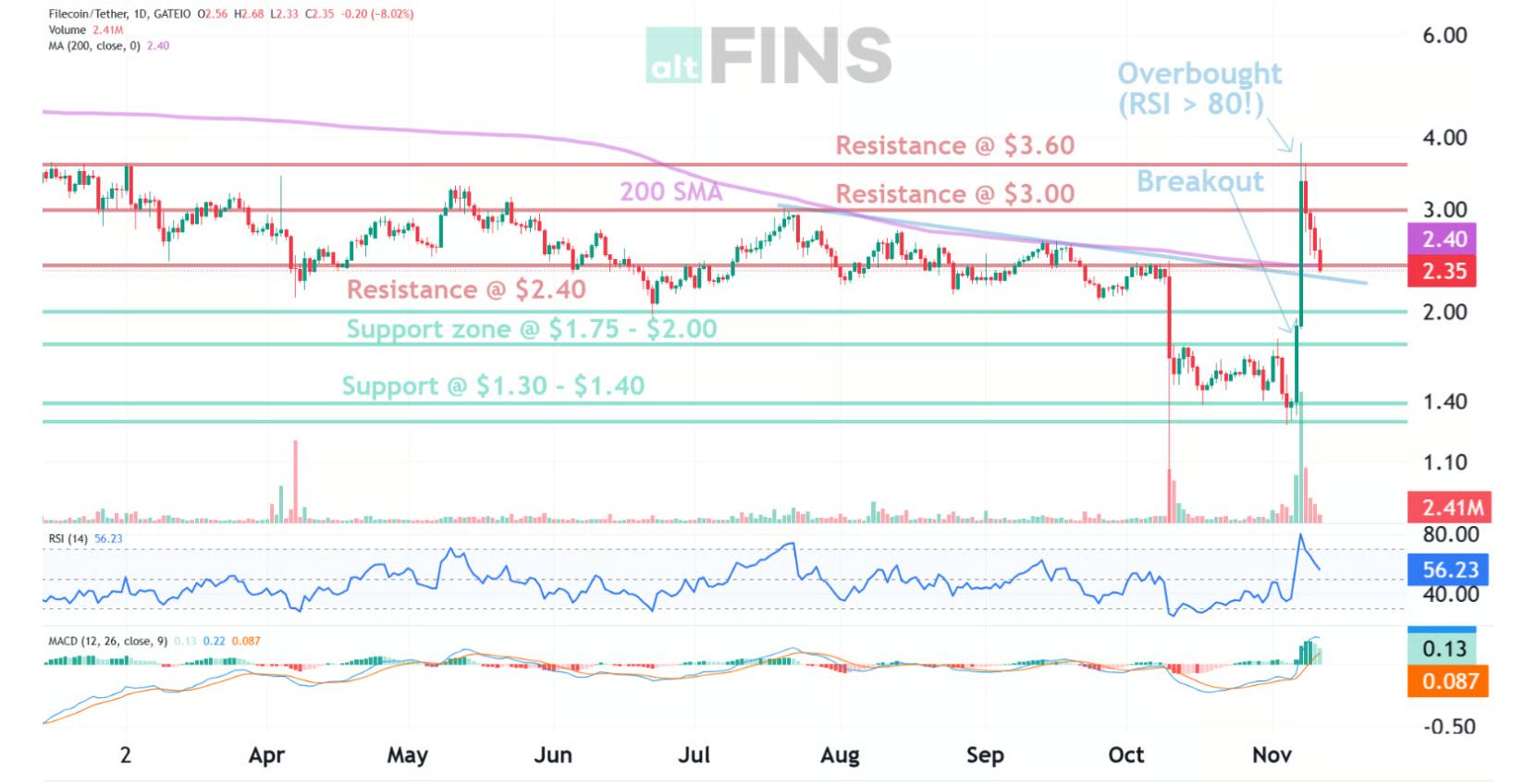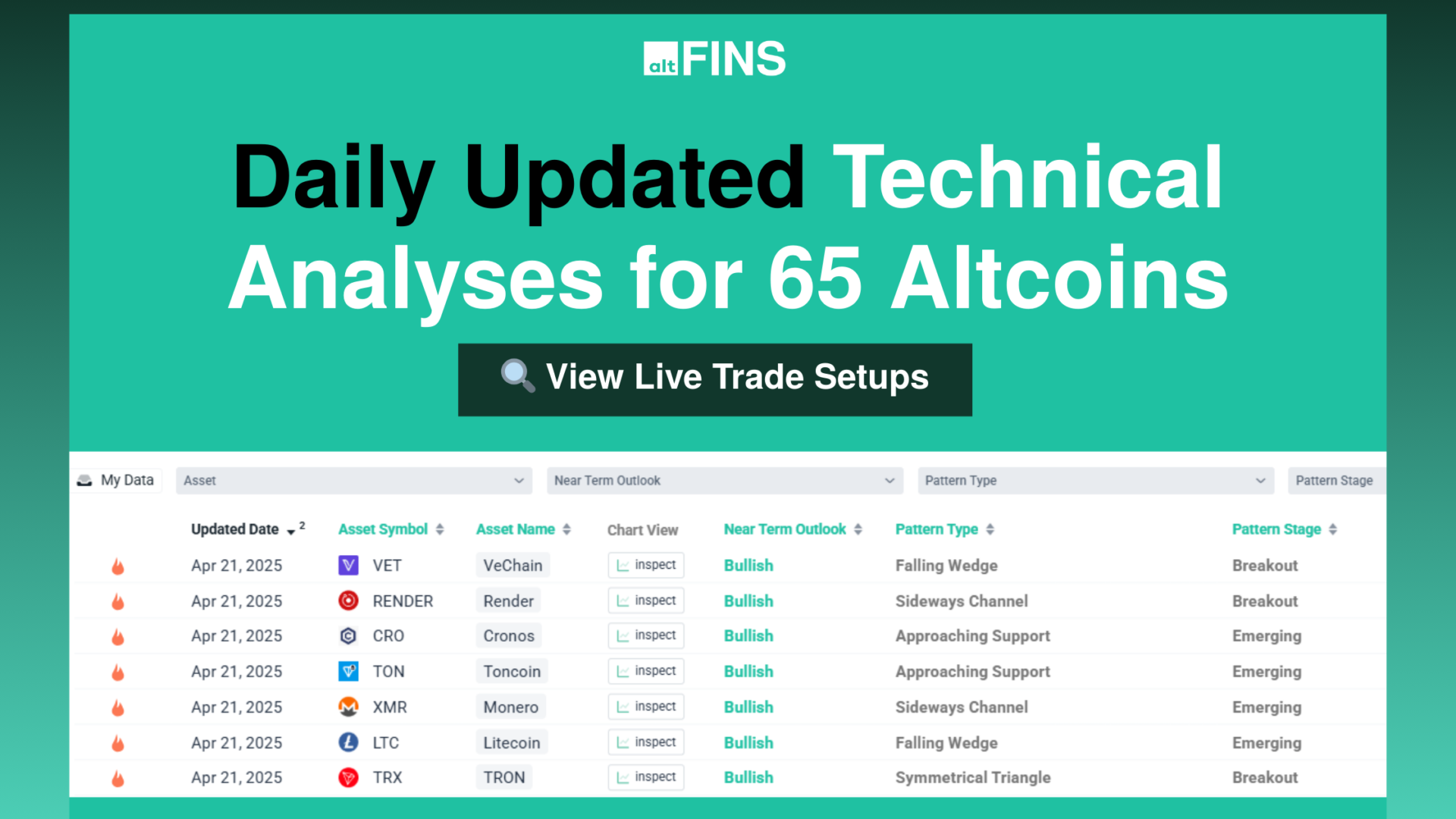Filecoin (FIL) Analysis
In addition to automated chart patterns, altFINS’ analysts conduct technical chart analyses of top 30 cryptocurrencies. We call these Curated Charts and they evaluate 5 core principals of technical analysis: Trend, Momentum, Patterns, Volume, Support and Resistance.
Filecoin (FIL) technical analysis:
Trade setup: Price broke back above a stiff resistance at $2.40 as it also lines up with 200 SMA and down trendline. This could signal resumption of Uptrend. It spiked up as high as $3.61 but got very overbought (RSI > 80!) at resistance and is pulling back on profit taking by traders. We’ll watch if it can find support at the $2.40 (200 SMA) critical level, which could be a swing trade entry possibly. Learn to trade breakouts in Lesson 7 and Risk Management in Lesson 9.
Pattern: Price is Approaching Support, which is a level where it could pause or reverse its recent decline, at least temporarily. Support is often a level where price has bounced up in the past, or potentially prior Resistance level that was broken. (concept known as polarity). Once price breaks below support, it can move lower to the next support level. Learn to trade key levels in Lesson 7.
Trend: Short-term trend is Strong Up, Medium-term trend is Neutral, Long-term trend is Strong Down.
Momentum is Bullish but inflecting. MACD Line is still above MACD Signal Line but momentum may have peaked since MACD Histogram bars are declining, which suggests that momentum could be nearing a downswing. Price is neither overbought nor oversold currently, based on RSI-14 levels (RSI > 30 and RSI < 70).
Support and Resistance: Nearest Support Zone is $2.00, then $1.75. Nearest Resistance Zone is $2.40, then $3.00.
 See live Filecoin (FIL) chart here.
See live Filecoin (FIL) chart here.
See more curated charts of top 60 coins.
Recent news and research:
Filecoin Expands to Onchain Cloud Services, Opening Waitlist
Filecoin (FIL) Outshines Major Ethereum Killers With 16% Jump, Here’s Reason
Crypto Influencer Says These 3 Cloud Storage Altcoins Could ‘Go Parabolic’
FIL on the rise: Filecoin’s upcoming production cut alters tokenomics
Binance to Support Filecoin (FIL) Hardfork. Here’s What Changes in Filecoin
Grayscale Acquires Huge Amounts of Recently Added Alts: BAT, MANA, LPT, FIL, LINK
Find more real-time news here.
What is Filecoin (FIL)?
Find full description and news on altFINS platform.
Overview
Filecoin is a decentralized data storage network built by Protocol Labs that allows users to sell their excess storage on an open platform. It acts as the incentive and security layer for IPFS (InterPlanetary File System), a peer-to-peer network for storing and sharing data files. Filecoin turns IPFS’ storage system into an “algorithmic market,” where users pay storage providers in Filcoin’s native token, FIL, to store and distribute data on the network.
History
Filecoin is looking to provide an alternative to traditional online storage providers and protocols. Its technology acts as an incentive layer for the peer-to-peer file transfer system IPFS (InterPlanetary File System), which uses hash-addressed content structures to store data instead of centralized servers and IP addresses. This is intended to reduce redundancy, increase permanence, and improve efficiency.
Filecoin incentivizes IPFS by rewarding storage providers and retrievers for contributing resources to the system. The network also comes with built-in Ethereum integration allowing developers to access data on Ethereum’s blockchain and interact with its smart contracts. Filecoin is being developed by Protocol Labs, a development firm founded in 2014 by Juan Benet. Benet and crew constructed Filecoin and IPFS in tandem, raising a few Seed equity rounds to fund the process.
In 2017, the team hosted a token sale to secure funds for Filecoin’s development, which raised around $205 million in one of the largest token offerings at the time. Protocol Labs seeks to build a fundamental layer for data infrastructure that can be used by both blockchain and traditional providers, like Amazon Web Services (AWS) and Microsoft Azure. The project plans to achieve this goal by creating a marketplace in which any user who has storage capacity can connect to the network, creating a supply of unused storage both in consumer hardware as well as data centers of existing businesses. The Filecoin team believes this will reduce the price of storage in a way similar to how sharing economy companies like Airbnb reduced the price of short-term rentals in marketplaces traditionally dominated by large players with large capital requirements.
Technology
Protocol Labs introduced many new technologies in its Filecoin whitepaper that could add value to multiple blockchain projects. Filecoin is secured by proof-of-work in the same way that bitcoin is, but this work is specifically related to storage of data Instead of finding a random nonce to make the block hash fit in a target range, the networks proof-of-work is restricted to proving that a miner has stored data for a specific duration and replication. This is achieved with two new types of proof-of-work: proof-of-replication (PoRep) and proof-of-spacetime (PoSt).
Proof-of-replication allows a server to convince a user that some data has been replicated to its own uniquely dedicated physical storage while proof-of-spacetime allows an efficient prover to convince a verifier that they are storing some data for a specified duration of time. These proofs allow Filecoin to solve issues with large-scale storage networks made of independent parties, by making it theoretically impossible to falsify data storage records to increase miner rewards.
Competitors like Siacoin ($SC) and Storj ($STORJ) lack this functionality, though they have not yet created enough storage demand for this to be a significant issue. Miner proofs are used to create a network based on three primary methods, put, get, and manage. The put and get methods are responsible for putting data in storage and accessing it on client request respectively. The manage method is responsible for managing the marketplace by matching buy and sell orders as well as managing buyer and seller reputation on the platform. These methods are executed across two marketplaces, storage and retrieval, which are managed by the different miners.
Protocol Labs believes that miners will often participate in both markets. Storage miners are responsible for receiving put requests and storing client data while also pledging collateral proportional to the data. They will be penalized by losing this collateral in the event of invalid or missing proofs. Storage providers run the manage method in conjunction with clients and auditors. Retrieval miners are responsible for managing get requests and giving clients their data. While retrieval miners do not need to pledge collateral, they are still compensated in the native Filecoin for performing work for the network.
Consensus Details
Proof-of-Replication (PoRep) and Proof-of-Spacetime (PoSt) The Filecoin protocol intends to use Proof-of-Replication (PoRep) and Proof-of-Spacetime (PoSt) to prove files are stored securely over time within a decentralized network. PoRep is a type of Proof-of-Storage featuring the specific properties that outlined in this post PoSt defines the mechanism by which miners create blocks that are storing data. Clients (network users) can source miners of data storage and data retrieval, different operations that existing within separate decentralized markets. PoSt provides a level of verifiability so that data can be stored and retrieved in a distributed, multi-market system. Mining Storage miners can earn FIL by storing data for clients and “computing cryptographic proofs to verify storage across time.” Unlike Proof-of-Work mining, the probability of earning a block reward (and transaction fees) is “proportional to the amount of storage the miner contributes to the network.” On the other hand, retrieval miners can receive FIL by winning bids for a client request.
The market value of the file in question determines the miner’s payout. Available bandwidth and initial response time for details (which could be influenced by network latency or proximity to a client) impact a miner’s ability to close deals and retrieve data on the network. Therefore, the “maximum bandwidth of a retrieval miner will set the total quantity of deals” they can win. With the network still in development, the mining equipment specifications (specifically for CPU and RAM) remain unknown. But the team insists the mining hardware will contain configurations with many standard hard drives and that any “specialized Filecoin mining hardware” will not exceed anything more than a highly optimized hard drive (in a sense, not optimal for ASICs). Filecoin also notes note that early storage and retrieval miners will be required to run full nodes.
About altFINS
altFINS is the best crypto analytics platform. The platform will help you find the right crypto trading opportunities. You can search for coin in Uptrend, with Momentum or Breakouts. It’s is great for advanced traders but also for beginners to learn basics of technical analysis in Crypto trading Course or in Curated charts or Chart pattern sections. But also more advanced traders can create their own Screens and Alerts of coins with different trading strategies.


1 Comment
FilecoinVS December 12, 2021
Thank you for this wonderful post.